The Kamchadals regard Mount Kamchatka as the dwelling place of the dead; they say that when it emits flames, it means the dead are heating up their yurts. According to them, the dead live on whale blubber, trap whales in a subterranean sea, and burn whale oil for light. They use whale bones instead of wood to heat their homes. To support their belief, they say that some of their countrymen have gone into the interior of this mountain, where they saw the habitations of their forebears. Steller says that they consider this mountain the home of spirits. When anyone questions them, he adds, about what goes on in this spirit world, they reply that the spirits cook whales. If they are asked where the spirits got the whales, they reply that the whales came from the sea, that the spirits leave the mountains at night and take so many whales that some bring back as many as five or even ten, one on each of their fingers. If they are asked who told them all these things, they reply: Our fathers told us this. As proof they offer the whale bones, which actually are found in large numbers on all the volcanoes.Stepan Krasheninnikov was a member of the Second Kamchatka Expedition, led by Vitus Bering and sponsored by the Russian government, which aimed to survey the resources of Russia's possessions in its far northeast, including parts of what is now Alaska, at a time when those regions were all but unknown to science. The Steller mentioned above was the naturalist Georg Wilhelm Steller, another notable participant in the expedition (and namesake of the extinct Steller's sea cow).
Explorations of Kamchatka 1735-1741, translation by E. A. P. Crownhart-Vaughan (Oregon Historical Society, 1972). I have modernized the spelling of one word.
Krasheninnikov's account probably should be better known; he was a pioneering geographer and a capable and relatively unprejudiced anthropologist. Though he was sometimes wrong, as in firmly declaring that whales were fish, there is much of value in his account, which is out of print but not that hard to find. The Oregon Historical Society edition (the only complete English-language version) could have used more explanatory notes but is otherwise a noble undertaking.
Image Credit: "The Volcano of Awatcha (Avacha) in Kamchatka, Siberia." Etching with engraving, from the Wellcome Collection. A different engraving of the same image is reproduced in Explorations of Kamchatka.















































